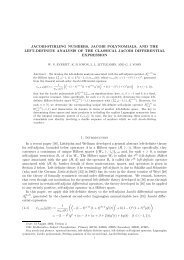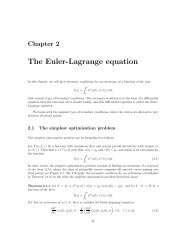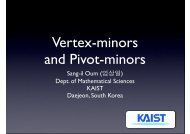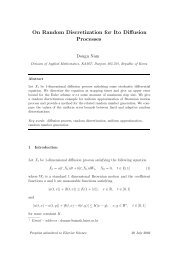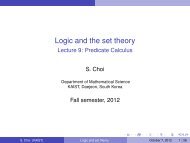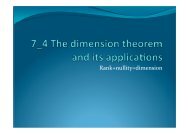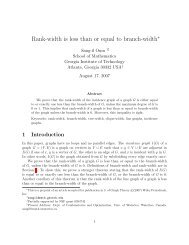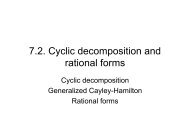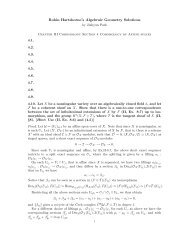THE CURVELET TRANSFORM FOR IMAGE FUSION
THE CURVELET TRANSFORM FOR IMAGE FUSION
THE CURVELET TRANSFORM FOR IMAGE FUSION
You also want an ePaper? Increase the reach of your titles
YUMPU automatically turns print PDFs into web optimized ePapers that Google loves.
5TABLE IA COMPARISON OF <strong>IMAGE</strong> <strong>FUSION</strong> BY <strong>THE</strong> WAVELETS, <strong>THE</strong> <strong>CURVELET</strong>S,AND IHS METHODS.Method C.E M. G C.COriginal 14.1035 -Images 4.1497 17.9416 -(R,G,B) 13.3928 -Image fused 15.7327 0.8134by IHS 2.8135 15.4414 0.9585(F1, F2, F3 ) 15.0168 0.9303Image fused 16.5891 0.9013by Wavelet 5.8611 18.9083 0.9176(F1, F2, F3 ) 17.0362 0.8941Image fused 19.5549 0.9067by Curvelet 5.8682 22.8330 0.9318(F1, F2, F3 ) 20.9101 0.9119where M and N are the length and width, in terms of pixelnumber, of an image f. The mean gradient (M.G.) reflects thecontrast between the detailed variation of pattern on the imageand the clarity of the image.The correlation coefficient is defined asCorr(A, B) =∑m,n (A mn − A)(B mn − B)√( ∑ m,n (A mn − A) 2 )( ∑ m,n (B mn − B) 2 )where A and B stand for the mean values of the correspondingdata set. The correlation coefficient (C.C.) between the originaland fused image shows similarity in small size structuresbetween the original and synthetic images. In Table I, the meangradient and the correlation coefficient of the curvelet-basedimage fusion method are greater than those of the waveletbasedimage fusion method. Hence, we can see that thecurvelet-based fusion method is better than the wavelet-basedfusion method in terms of the mean gradient and correlationcoefficient.Based on the experimental results obtained from this study,the curvelet-based image fusion method is very efficient forfusing Landsat ETM+ images. This new method has yieldedoptimum fusion results.V. CONCLUSIONWe have presented a newly developed method based on acurvelet transform for fusing Landsat ETM+ images. In thispaper, an experimental study was conducted by applying theproposed method, as well as other image fusion methods,to the fusion of Landsat ETM+ images. A comparison ofthe fused images from the wavelet and IHS method wasmade. Based on experimental results pertaining to three indicators- the combination entropy, the mean gradient, and thecorrelation coefficient- the proposed method provides betterresults, both visually and quantitatively, for remote sensingfusion. Since the curvelet transform is well adapted to representpanchromatic images containing edges and the wavelettransform preserves the spectral information of the originalmultispectral images, the fused image has both high spatialand spectral resolution.,ACKNOWLEDGMENTThe authors would like to express their sincere gratitudeto Electronics and Telecommunications Research Institute forproviding the Landsat ETM+ images for this research.REFERENCES[1] T. Ranchin and L. Wald, “Fusion of High Spatial and Spectral Resolutionimages: The ARSIS Concept and Its Implementation,” PhotogrammetricEngineering and Remote Sensing, vol. 66, 2000, pp. 49-61.[2] L. Wald, T. Ranchin and M. Mangolini, “Fusion of Satellite images ofdifferent spatial resolution: Assessing the quality of resulting images,”Photogrammetric Engineering and Remote Sensing, vol. 63, no. 6, 1997,pp. 691-699.[3] J. Nunez, X. Otazu, O. Fors, A. Prades, V. Pala and R. Arbiol,“Multiresolution-based image fusion with addtive wavelet decomposion,”IEEE Transactions on Geoscience and Remote sensing, vol. 37, no. 3,1999, pp. 1204-1211.[4] E. J. Candès, “Harmonic analysis of neural networks,” A ppl. Comput.Harmon. Anal., vol. 6, 1999, pp. 197-218.[5] E. J. Candès and D. L. Donoho, “Curvelets- A surprisingly effectivenonadaptie representation for objects with edges,” in Curve and SurfaceFitting: Saint-Malo, A. Cohen, C.Rabut, and L.L.Schumaker, Eds.Nashville, TN: Vanderbilt Univ. ersity Press, 1999.[6] J. L. Starck, E. J. Candès and D. L. Donoho, “The curvelet transformfor image denosing,” IEEE Trans. Image Processing, vol. 11, 2002, pp.670-684.[7] J. L. Starck, E, J. Candès, and D. L. Donoho, “Gray and Color ImageContrast Enhancement by the Curvelet Transform,” IEEE Trans. ImageProcessing, vol. 12, no. 6, 2003, pp. 706-717.[8] E. J. Candès, “Ridgelets: Theory and Applications,” Ph.D. Thesis, Departmentod Statistics, Stanford University, Standford, CA, 1998.[9] D. L. Donoho, “Digital ridgelet transform via rectopolar coordinatetransform,” Stanford Univ., Stanford, CA, Tech. Rep, 1998.[10] D. L. Donoho, “Orthonormal ridgelets and linear singularities,”SIAM J. Math Anal., vol. 31, no. 5, 2003, pp. 1062-1099.[11] I. Daubechies, “Ten Lectures on Wavelets,” CBMS-NSF series inApplied Mathematics, SIAM, Philadelphia, 1992.[12] P. G. Lemarié and Y. Meyer, “Ondelettes et bases Hilbertiennes,” Rev.Mat. Iberoamericana, 2, 1986, pp. 1-18.[13] S. R. Deans, “The Radon Transform and Some of Its Application,” NewYork: Wiley, 1983.[14] J. L. Starck, F. Murtagh and R. Bijaoui, ”Image Processing and DataAnalysis: The Multiscale Approach,” Cambridge, U.K.: Cambridge Univ.Press, 1998.[15] J. Li and Z. J .Liu, “Data fusion for remote sensing imagery basedon feature,” China Journal of Remote Sensing, vol. 2, no. 2, 1998, pp.103-107 (in Chinese with abstract in English).[16] W. Z. Shi, C. Q. Zhu, C. Y. Zhu and X. M. Yang, “Multi-Band Waveletfor Fusing SPOT Panchromatic and Multispectral Images,” PhotogrammetricEngineering and Remote Sensing, vol. 69, no. 5, 2003, pp . 513-520.[17] J. B. Sun, J. L. Liu and J. Li, “Multi-source remote sensing image datafusion,” China Journal of Remote Sensing, vol. 2, no. 1, 1998, pp. 47-50(in Chinese with abstract in English).



